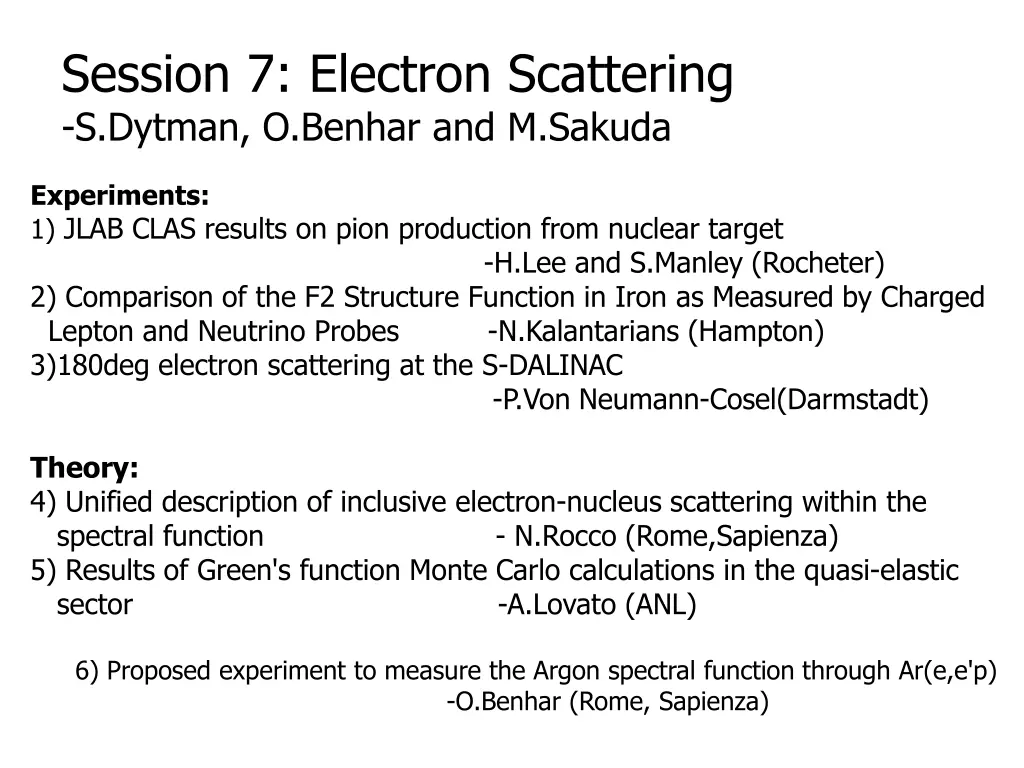
Electron Scattering Experiments and Theory
Explore a range of electron scattering experiments and theoretical studies in nuclear physics, covering topics such as pion production, F2 structure function, spectral functions, and cross-section measurements. Dive into the latest research findings and proposed experiments in the field of electron-nucleus scattering.
Download Presentation

Please find below an Image/Link to download the presentation.
The content on the website is provided AS IS for your information and personal use only. It may not be sold, licensed, or shared on other websites without obtaining consent from the author. If you encounter any issues during the download, it is possible that the publisher has removed the file from their server.
You are allowed to download the files provided on this website for personal or commercial use, subject to the condition that they are used lawfully. All files are the property of their respective owners.
The content on the website is provided AS IS for your information and personal use only. It may not be sold, licensed, or shared on other websites without obtaining consent from the author.
E N D
Presentation Transcript
Session 7: Electron Scattering -S.Dytman, O.Benhar and M.Sakuda Experiments: 1) JLAB CLAS results on pion production from nuclear target -H.Lee and S.Manley (Rocheter) 2) Comparison of the F2 Structure Function in Iron as Measured by Charged Lepton and Neutrino Probes -N.Kalantarians (Hampton) 3)180deg electron scattering at the S-DALINAC -P.Von Neumann-Cosel(Darmstadt) Theory: 4) Unified description of inclusive electron-nucleus scattering within the spectral function 5) Results of Green's function Monte Carlo calculations in the quasi-elastic sector -A.Lovato (ANL) - N.Rocco (Rome,Sapienza) 6) Proposed experiment to measure the Argon spectral function through Ar(e,e'p) -O.Benhar (Rome, Sapienza)
1) JLAB CLAS results on pion production from nuclear target -H.Lee and S.Manley (Rocheter) High statistics inclusive 1 +-production data to understand pion nuclear effects. e+A e+ 1 +-+ N + X 1 +-+
CLASS (d/dp,Q2,W,) on e+Ae+ 1+-+ N + X (A=D,C,Fe,Pb) [Preliminary]
2) Comparison of the F2 Structure Function in Iron as Measured by Charged Lepton and Neutrino Probes -N.Kalantarians (Hampton) A key to F2Fe/F2Dproblem with leptons and neutrinos F2D (right) was constructed with nCTEQ, which is based largely based on charged lepton data. F2Fe only (left), for neutrino and charged lepton scattering data. The difference is in the (anti) shadowing region, We need more neutrino-deuteron scattering data. We need more F2D data with neutrinos.
3) 180deg electron scattering at the S-DALINAC -P.Von Neumann-Cosel (Darmstadt) 180deg= Only Transverse contributes = responce
Cross section measurements ( multipoles) in supernova energy region (Ee~50-130MeV) Good data for multipoles + QE at 50-100MeV region
Wealth of data in C(e,e) to test your models for Ee= 150MeV - 2000MeV Low energy excitations in RPA calculations-N.Jachowicz (Gent) QE is being tested for Ee>200MeV. Ankowski etal,PRC91,033005 (NuInt14).
Summary and Outlook Harry T.-S. Lee (ANL): Tons of data to test your models . We have also many electron scattering data at various kinematic regions (E,q) to test your models. QE: Not only the vector part of the cross setion, but also the nuclear effects (Initial and Final State Interactions, transparency, Pauli, 1p1h, 2p2h, MEC) can be tested. Possible new data at S-DALINAC in 50-130MeV. CLASS pion data from non-resonant, resonant and DIS region. A good analysis on F2Fe/F2D: A hint to solve difference seen in F2Fe/F2D. We need new data on F2D with neutrinos. Theory: Already given. Outlook: Electron Scattering data are/will be as valuable as neutrino scattering data to understand lepton-nucleus interactions and nuclear effects.
Form Factors (Cross Sections) for C-12 Giant Resonances (1+,1-,2-)
